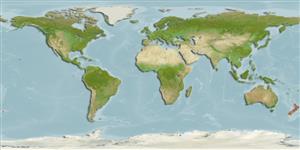Teleostei (teleosts) >
Beloniformes (Needle fishes) >
Hemiramphidae (Halfbeaks)
Etymology: Hyporhamphus: Greek, hypo = under + Greek, rhamphos = beak, bill (Ref. 45335).
Environment: milieu / climate zone / depth range / distribution range
Ecology
Marine; pelagic-neritic; depth range 0 - ? m. Temperate
Southwest Pacific: restricted to New Zealand, including the Chatham Islands.
Size / Weight / Age
Maturity: Lm ? range ? - ? cm
Max length : 26.0 cm SL male/unsexed; (Ref. 10988); common length : 22.0 cm TL male/unsexed; (Ref. 9258)
Dorsal spines (total): 0; Dorsal soft rays (total): 15 - 18; Anal spines: 0; Anal soft rays: 17 - 20; Vertebrae: 55 - 58. Gill rakers usually 32 or less on the first arch and 25 or less on the second arch. Relatively longer upper jaw (usually longer than wide) and lower jaw (usually longer than head length), especially at larger sizes.
Occurs in inshore waters. Forms schools for spawning during mid summer (Ref. 9258). Feeds mainly on larger zooplankton like mysids, crab larvae and polychaete larvae (Ref. 26966).
Life cycle and mating behavior
Maturity | Reproduction | Spawning | Eggs | Fecundity | Larvae
Collette, B.B., 1974. The garfishes (Hemiramphidae) of Australia and New Zealand. Records of the Australian Museum 29(2):11-105. (Ref. 10988)
IUCN Red List Status (Ref. 130435: Version 2024-2)
Threat to humans
Harmless
Human uses
Fisheries: minor commercial
Tools
Special reports
Download XML
Internet sources
Estimates based on models
Phylogenetic diversity index (Ref.
82804): PD
50 = 0.5000 [Uniqueness, from 0.5 = low to 2.0 = high].
Bayesian length-weight: a=0.00102 (0.00046 - 0.00225), b=3.06 (2.88 - 3.24), in cm total length, based on all LWR estimates for this body shape (Ref.
93245).
Trophic level (Ref.
69278): 3.2 ±0.3 se; based on diet studies.
Resilience (Ref.
120179): High, minimum population doubling time less than 15 months (Preliminary K or Fecundity.).
Fishing Vulnerability (Ref.
59153): Low vulnerability (22 of 100).
Climate Vulnerability (Ref.
125649): High to very high vulnerability (73 of 100).
Nutrients (Ref.
124155): Calcium = 240 [58, 580] mg/100g; Iron = 0.655 [0.226, 1.848] mg/100g; Protein = 17.8 [15.0, 20.0] %; Omega3 = 0.518 [0.215, 1.478] g/100g; Selenium = 6.33 [2.15, 16.41] μg/100g; VitaminA = 59.3 [11.7, 294.2] μg/100g; Zinc = 0.776 [0.306, 2.099] mg/100g (wet weight); based on
nutrient studies.
